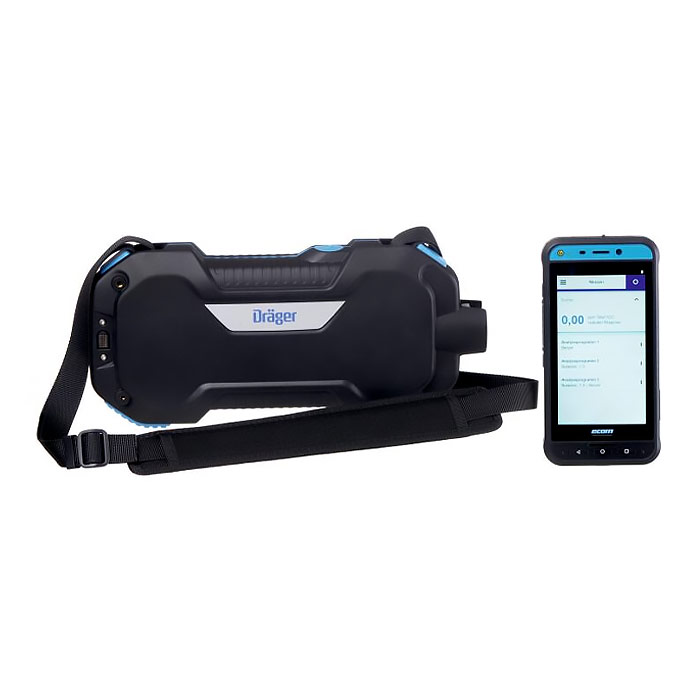Drager X-pid 9500 Portable Gas Detector
The Drager X-pid 9500 is a highly capable and adaptable gas measurement device that utilizes selective PID technology. It has a vast range of features and applications that make it an essential tool for professionals in different industries. The device’s innovative technology enables fast and accurate measurements, while its cost-effectiveness makes it a valuable investment. Whether you need to test for hazardous toxic substances, monitor industrial hygiene, or respond to emergencies, the X-pid 9500 is a reliable and efficient solution.
MME Shopping Event
Hurry and get discounts on Most of MME Products up to 20%
Call for Price
Drager X-pid 9500 Portable Gas Detector
The Drager X-pid 9500 is a selective PID (photoionization detector) gas measurement device designed for users who frequently test for hazardous toxic substances such as benzene, butadiene, and other volatile organic compounds (VOCs). This innovative device offers laboratory-quality results in a short time, even in the presence of other gases. In this article, we will discuss the key features, applications, and benefits of the Drager X-pid 9500.
Key Features
Innovative Technology
The Dräger X-pid 9500 utilizes gas chromatography with photoionization detection, allowing for selective measurement of target compounds. This technology enables the device to provide accurate and reliable results, even in complex gas mixtures.
Fast and Efficient Measurements
The Drager X-pid 9500 requires no preparation and is ready to use after a brief start-up phase. Selective measurement in “Analysis” mode takes only a few seconds, and a benzene measurement can be completed in just 30 seconds. The device is ready to measure for benzene again after another 60 seconds, saving considerable time compared to other detection systems.
Reduced Operating Costs
Operating costs can be reduced since the Drager X-pid 9500 does not use consumables for measurements. The device requires no pre-tubes, making it easier to use and preventing user errors. For users with high measurement needs, the X-pid 9500 quickly pays for itself, generally being more cost-effective than comparable measurement systems.
Applications
Hazardous Toxic Substance Testing
The Drager X-pid 9500 is ideal for users who frequently test for hazardous toxic substances such as benzene, butadiene, and other VOCs. The device’s selective measurement capabilities allow for accurate and reliable results, even in the presence of other gases.
Industrial Hygiene and Environmental Monitoring
The Drager X-pid 9500 can be used in various industrial and environmental monitoring applications, where the detection of specific toxic substances is crucial for ensuring safety and compliance with regulations.
Emergency Response and Hazmat Operations
The device’s fast and efficient measurement capabilities make it suitable for emergency response and hazmat operations, where rapid detection of hazardous substances is essential for protecting public health and safety.
Benefits
Laboratory-Quality Results
The Drager X-pid 9500 provides laboratory-quality results quickly, even when other gases are present. This ensures accurate and reliable measurements, enabling users to make informed decisions based on precise data.
Time Savings
The Drager X-pid 9500 offers significant time savings compared to other detection systems, with selective measurements taking only a few seconds and benzene measurements completed in just 30 seconds. This allows for more efficient monitoring and faster response times in critical situations.
Cost-Effectiveness
With no consumables required for measurements, the X-pid 9500 reduces operating costs and quickly pays for itself for users with high measurement needs. The device is generally more cost-effective than comparable measurement systems, making it an attractive option for organizations looking to optimize their budget.
Drager X-pid 9500 Portable Gas Detector Specifications:
- Dimensions (W x H x D): Ca. 132 x 281 x 56 mm
- Weight: Ca. 880 g (2 lb)
- Ambient conditions in operation:
- Temperature: -10 to +35 °C
- Pressure: 700 to 1,300 mbar
- Relative humidity: 10 % to 95 % RH
- Protection class IP54
- Start-up phase: Ca. 10 min, can be increased at low ambient temperatures
- Operating times Typically 8 h, reduces with lower ambient temperatures
- Approvals:
- ATEX: II 1G Ex ia IIC T4 Ga
- IECEx: Ex ia IIC T4 Ga
- cCSAus: Class I, Div. 1 Group A, B, C & D T4, Ex is, Class I, Zone 0, A/Ex ia IIC T4 Ga
- CE Markin: RED (Directive 2014/53/EU), ATEX (Directive 2014/34/EU)
You must be logged in to post a review.
Brand
Drager
Drager Tools
In the realm of safety and medical technology, Dräger stands as a global pioneer, renowned for its innovative solutions that save lives and enhance well-being. With a legacy rooted in excellence, the company has made significant contributions to fields such as medical equipment, gas detection, and personal protective equipment. This article delves into Drager's history, groundbreaking products, and unwavering commitment to advancing safety and healthcare.A Legacy of Innovation
Founded with a vision to improve human safety, Drager boasts a legacy of innovation that spans over a century. From its inception, the company's commitment to developing cutting-edge solutions has established it as a leader in the industry. Specifications
Specifications
| Gas detector | ||||||||||||||
|---|---|---|---|---|---|---|---|---|---|---|---|---|---|---|
| ||||||||||||||
| Mechanical and General Specifications | ||||||||||||||
| ||||||||||||||
Related Products
Testo 0632 1271 CO probe (digital) with Bluetooth®
In stock
testo 317-3 – CO meter for measuring CO in the surrounding air
In stock



Reviews
Clear filtersThere are no reviews yet.